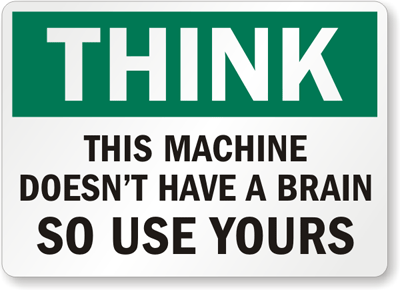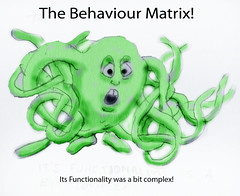 |
| Thought (Photo credits: www.mysafetysign.com) |
by Tabetha M. Cooper
Our ability to learn is what makes us successful in life. People have, at some point, learned from experience everything it is that they do. And in our society, the more expertise one has in a given area, the more likely that person will be to obtain, and hold, employment. We all know that learning is the acquiring of information, but the definition of learning goes deeper than that. So what is the definition of learning? Schacter, Gilbert, and Wegner (2009), define learning as “Some experience that results in a relatively permanent change in the state of the learner.” In other words, only the experiences that one remembers, or that in some other way affect one’s behavior, are classified as learning. Also, learning can be conscious or unconscious. Conditioning is one example of unconscious learning, and shows that we are not always aware of when we are learning.
During my research, I have come across many examples of various types of learning. One of the experiments with learning I have studied is called the Bobo Experiment. It is an experiment concerning observational learning, conducted by a man named Albert Bandura and his colleagues. In this experiment children around the age of four years old were placed in a room with age appropriate toys. In a corner of the room was an adult who also had various types of toys. Among one of the toys the adult had to play with was a Bobo doll. A Bobo doll is a plastic, blow-up doll with sand at the bottom to keep it upright. If one punches the doll it falls over and then pops back to an erect position. The adult in the room took the Bobo doll and started to play aggressively with it. They knocked it down, punched it, hit it with a plastic mallet, threw it up in the air, and even kicked it. The children in the room watched as the adult played roughly with the doll. A short time later the children were given the opportunity to play with this doll. Each child in the experiment played with the doll in the same aggressive manner that the adults had demonstrated. The manner the doll was played with by the adults was purposeful, so the researchers could see if the children did the same thing. Each child, indeed, hit the Bobo doll with a mallet, threw it in the air, hit, and kicked it. In some of the studies the children got to observe the adult getting punished for the aggressive behavior. In the cases where the children observed the adult being punished, the amount of aggressiveness used was much less or not at all.
 |
| Inside Bobo doll (Photo credit: Wikipedia) |
A recent discovery within the human brain (as well as the brains of birds and monkeys) is the mirror neuron. The mirror neurons are located in the frontal (close to the motor cortex) and parietal lobes. Mirror neurons activate when we perform a behavior as well as when we observe another person performing a behavior. From what I understand of mirror neurons, it follows that they have a direct relationship with observational learning. When we see someone doing something, our mirror neurons fire and we are more inclined to pay attention to and retain the behavior we saw. As we
observe a behavior that we have never seen or one which we desire to learn, these neurons help send what is being observed to the appropriate parts of the brain. We not only see what is going on but the mirror neurons help send the actions to the right place for our memory to store the information, so that we can perform the behavior ourselves at a later time.
 |
| 2012 Behaviour Matrix copy (Photo credit: Robin Hutton) |
I have learned a lot of things in my life through observational learning. In fact, I think I may learn better through observing then actively working with what I am trying to learn. I think that behaviors that come natural come from observational learning. For example, my mother is a really easy going person. She is also what one would call a pleaser, meaning she does whatever is asked of her whether she wants to or not. She puts everyone in the world before herself. I grew up watching not only these personality behaviorisms but the unhappiness that resulted from always doing for others, and never for her. I have grown up to be just like her. I honestly believe that the behaviors that I learned from watching her became instilled within me. Unlike her, doing for others before I do for myself has not made me unhappy, although I do find myself taking time away from the things that I need to get done. The word ‘no’ is not in my vocabulary. In the past, I had believed that this was a personality trait that I was born with. But, after studying about the different types of learning and seeing some examples, I no longer think this is the case. Now, I am convinced that I have observed these personality behaviorisms for so long, that it is just natural for me to behave in the same manner.
References
Schacter, Gilbert, Wegner; Psychology (2009) Chapter 3 pg. 78 and Chapter 6 (entire chapter)


















0 comments:
Post a Comment